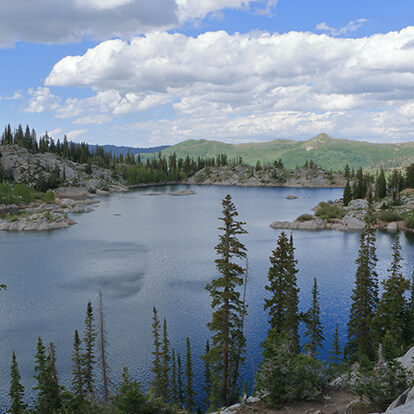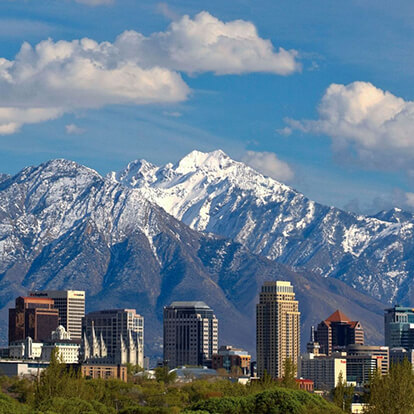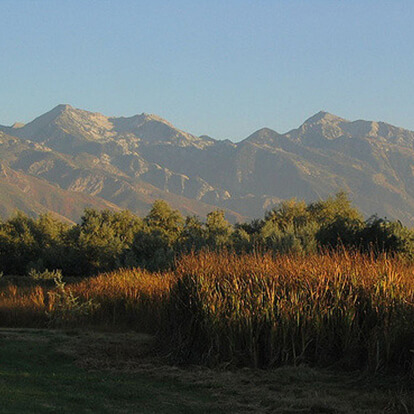Summer Activities
The forecast for summer activities in Brighton and Solitude UT calls for adventure or relaxation during the day, and cool and comfortable in the evening. Take advantage of the summer season by getting outside and exploring, but do bring layers! The temperature in the spring and summer months vary from highs in the 70s and 90s, to lows in the 40s and 60s.
We have compiled this list of summer must see places below. By combining this with your wish list of must haves, you’re sure to call Utah a summer vacation paradise. Get out and explore!
Big Cottonwood Canyon
Big Cottonwood Canyon, Utah is part of the majestic Wasatch Mountain Range that comprises the western slope of the Rocky Mountains in the western part of the United States. Big Cottonwood Canyon enjoys the same natural conditions as other areas of the Wasatch Mountains: low humidity, the lake effect and the “greatest snow on earth”. It is no wonder that the towns and resorts in Big Cottonwood Canyon are considered to be among the best ski resorts in the world. In 2002, the Olympic Winter Games were held in Salt Lake City, just a few minutes from Brighton Ski Resort and Solitude Mountain Ski Resort.
Big Cottonwood Canyon resides just a few miles north of Little Cottonwood Canyon where Alta and Snowbird ski resorts are located.
During the summer months, there are many activities in the Big Cottonwood Canyon area including hiking, rock climbing, picnicking, and fishing. Albion Basin at Alta and the Brighton Basin are famous for wildflowers and is one of the most photographed areas in northern Utah. Albion Basin is just a short 2.5 mile hike from Brighton. On your way to Albion Basin you will pass three of Northern Utah`s most beautiful lakes, Lake Mary, Lake Catherine and Lake Martha. Other activities for recreation enthusiasts in Big Cottonwood Canyon include mountain biking, disc golf, and trail running.
Little Cottonwood Canyon
Little Cottonwood Canyon, Utah lies only 15 miles from Salt Lake City and, like Big Cottonwood Canyon, is part of the majestic Wasatch Mountain Range, which comprises the western slope of the great Rocky Mountains. Little Cottonwood Canyon enjoys the same natural conditions as other areas of the Wasatch Mountains: low humidity, the lake effect, “Champagne powder” snow, and pristine scenery. Little Cottonwood Canyon houses two of the region`s best ski resorts: Alta Ski Resort and Snowbird Ski Resort. Snowbird claims Utah`s only aerial tramway that carries interested winter and summer visitors to the panoramic Hidden Peak at an elevation of 11,000 feet Just one mile beyond Snowbird is world-class Alta Ski Area, which was Utah`s second ski resort to open (1939) after Brighton Ski Resort opened in 1936.
Little Cottonwood Canyon resides just a few miles south of Big Cottonwood Canyon, which claims the Brighton and Solitude Ski Resorts.
During the summer months, there are many activities in the Little Cottonwood Canyon area including hiking, rock climbing, picnicking, and fishing. Albion Basin at Alta is famous for wildflowers and is one of the most photographed areas in northern Utah. Albion Basin is just a short 2.5 mile hike from Brighton. On your way to Albion Basin you will pass three of Northern Utah`s most beautiful lakes, Lake Mary, Lake Catherine and Lake Martha.
Salt Lake City
What many consider to be the world’s best ski resorts, Brighton, Solitude, Alta or Snowbird, are located just 40 minutes from Salt Lake City, Utah, home of the 2002 Winter Olympics. Salt Lake City has direct service from most major metropolitan cities in North America. It is possible to catch a morning flight from New York, Boston or Washington DC and be skiing the best snow in the world that very afternoon.
Salt Lake City is located in a valley between two mountain ranges – the Wasatch Mountain Range on the eastern side and the Oquirrhs on the western side. In all, Salt Lake City offers ten world-class ski resorts and the best of those are Brighton, Solitude, Alta and Snowbird. The climate is comfortable year-round because of the low humidity and sunny days.
Salt Lake City is not just for skiers or snowboarders. These world-class ski resorts morph into spectacular outdoor gardens and playgrounds as soon as the snow melts. A photographer’s dream, these resort towns offer first-class hiking, foliage, rock climbing, fishing, camping and picnicking and provide a good base from which to drive to 10 national parks.
Want to spend a day out of the sun? Salt Lake City is also a thriving cultural center offering its own symphony orchestra, opera, dance and theater company, choir and numerous art galleries and museums. Most visitors will tour Temple Square and journey to the world famous Great Salt Lake.
Interesting Things to Know About Salt Lake City, Utah History
- Salt Lake City was founded in 1847 by a group of Mormons led by Brigham Young. They were the first non-Indians to settle the region. The founding group numbered 148 people consisting of 143 men, 3 women and 2 children.
- The first known residents, however, were the Pueblo People who were also called Anasazi Indians. They occupied the region from 1 AD to 1300 AD. The Navajo Indians and the Ute Tribe also settled and roamed the region. The state name of Utah is derived from the Utes.
- The Mormons settled the region of Utah because they needed a place to call their own, a place to practice their religion, today known as the Church of Jesus Christ of Latter Day Saints. Logic went into the planning of the Salt Lake City: city blocks were centered by Temple Square and were arranged in a grid pattern in 10-acre squares separated by streets wide enough (132 feet) so that a team of 4 oxen pulling a covered wagon could turn around.
- The seagull is Utah’s state bird because it saved the region from starvation in the mid-1850`s when it consumed a plague of crickets that had run rampant on the Mormon harvest.
- In 1848, Utah was ceded to the Union by Mexico. The Mexican state of Deseret became known as the Utah Territory. The name deseret is translated to honeybee in English which means industriousness. Today, the honeybee is the state symbol.
- Construction on the great Mormon temple began in 1853. The temple was constructed of large granite blocks individually hauled from Little Cottonwood Canyon by ox until a branch railroad line was built.
- Brighton Village at the top of Big Cottonwood Canyon, where Brighton Ski Resort is located, was where for many years where Utah families of means would spend their summers. Located only 20 miles from Salt Lake City, Brighton offered a cool and pristine escape from the warm days of summer in the Salt Lake Valley. Today, many of these pioneer cabins still exist.
Wasatch Mountain Range
The Wasatch Mountain Range extends from southern Idaho and Wyoming into central Utah. The Range is identified as the western edge of the Rocky Mountains. The name Wasatch is derived from a native American tribe that settled in that region. Within the Wasatch Mountain range are Utah`s most popular ski resorts – Brighton, Solitude, Alta, Snowbird, Park City, The Canyons, Deer Valley and Sundance. Two of the best known canyons within the Wasatch Mountain range are Big Cottonwood Canyon and Little Cottonwood Canyon.
Almost 85% of Utah`s population resides within 15 miles of the Wasatch Mountains because the region is located where many river water drainages exit the mountains. In early years, the mountains were a source of water, timber, granite, zinc, lead and silver (and gold). But, today, they are best known for providing world-class recreation activities for residents and visitors.
Many of the today`s most popular ski resorts were originally mining towns that reached their zenith in the late 1800`s. Fortunately, once minerals were exhausted, a new resource was discovered – snow perfect for skiing and snowboarding. Big and Little Cottonwood Canyons are considered to have some of the best snow in the world. Original mining towns such as Brighton and Alta have come back to life in the form of world-renowned ski resorts. Where once miner`s shacks dotted the hillsides, today Cottonwood Lodging Properties rents a range of Utah vacation home rentals – some ski in / ski out – that are convenient to Brighton, Solitude, Alta and Snowbird ski resorts.
During the summer months, hiking is a favored activity. Within Big and Little Cottonwood Canyons there is an extensive network of trails that lead to mountain lakes, peaks with stunning vistas and beautiful forests. One can even hike between the resort towns of Brighton, Solitude, Alta and Snowbird. Brighton makes an excellent central location to explore the Big and Little Cottonwood Canyons.




